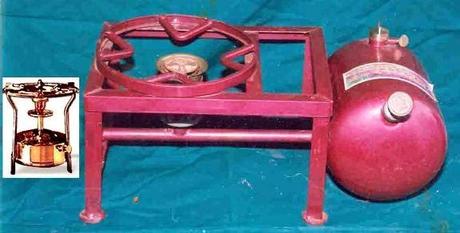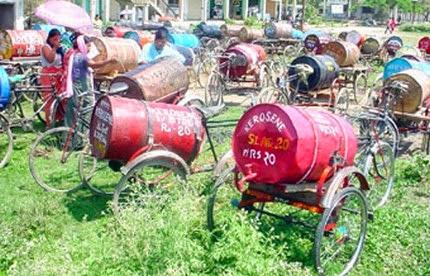Life has changed in the fast lane in the days of piped LPG supply, induction stoves and the like … gone are the days when people struggled with stoves – initially wick stoves and then pump stoves (lighting a pump stove itself was an arduous task) ……… miles away Kenya’s energy regulator raised the maximum retail price of a liter of diesel and kerosene and lowered that of petrol, reflecting their import costs. Fuel prices have a big effect on inflation in east Africa’s biggest economy, which relies heavily on diesel for transport, power generation and agriculture, while kerosene is used in many households for cooking and lighting.
 Some present day youngsters may not know that the fuel used was
‘kerosene’ and there was mad scramble for buying it (remember standing in
serpentine queues for long hours) ….. in later years it was regulated and
issued through fair price shops (read Ration shops) – in earlier days, there
were kerosene depots and hawkers would roam in the streets in a contraption
called ‘kerosene carts’ pulled manually and some adapted in a cycle rickshaw.
Some present day youngsters may not know that the fuel used was
‘kerosene’ and there was mad scramble for buying it (remember standing in
serpentine queues for long hours) ….. in later years it was regulated and
issued through fair price shops (read Ration shops) – in earlier days, there
were kerosene depots and hawkers would roam in the streets in a contraption
called ‘kerosene carts’ pulled manually and some adapted in a cycle rickshaw.
 Photo credit : e-pao.net
Photo credit : e-pao.net
Kerosene is a combustible hydrocarbon liquid. The name is derived from Greek: ‘keros’ meaning wax. The word "Kerosene" was registered as a trademark by Abraham Gesner in 1854, and for several years, only the North American Gas Light Company and the Downer Company (to which Gesner had granted the right) were allowed to call their lamp oil "Kerosene" in the United States – then it became a generic name. Kerosene is widely used to power jet engines of aircraft (jet fuel) and some rocket engines, but is also commonly used as a cooking and lighting fuel. In parts of Asia, where the price of kerosene is subsidized, it fuels outboard motors on small fishing boats. Kerosene lamps are widely used for lighting in rural areas of Asia and Africa where electrical distribution is not available or too costly for widespread use.
The introduction of the first pressurized burner portable stove is generally credited to Frans Wilhelm Lindqvist, in 1892. Lindqvist's stove was based on the pressurized blowtorch but fitted with an upturned burner assembly of his own design. The kerosene burning Primus stoves and their imitators were made of brass and were a significant advance over previous designs, which had used a wick to supply liquid fuel to the burner by capillary action. The Primus burner vaporized the fuel in a loop of pipe which rose up from the fuel tank at the stove's base.
Today’s The Hindu reports that the Delhi Government announced that the national capital has become the first ‘kerosene-free city’ in the country. “With the successful implementation of Delhi: A Kerosene-Free City Scheme, 2012, no subsidised kerosene is being issued in the national capital and the country can save upto Rs 200 crores every year,” said S.S. Yadav, Commissioner, Food Supply and Weights and Measures. The scheme was launched in 2012 in collaboration with three Oil Marketing Companies and Union Ministry of Petroleum and Natural Gas for which Delhi Government had incurred an expenditure of Rs 62 crores.
Delhi was earlier getting about 53,000 Kilolitre of kerosene oil every year from the Centre, which was issued to eligible households at a subsidised rate. At the present market rate of the oil, it would have cost the government about Rs 200 crores per year as subsidy, Mr. Yadav said. “Under the scheme, free gas connections along with LPG filled cylinders, two burner gas stove, regulator and suraksha pipe were issued to the Jhuggi Ration Card (JRC), Below Poverty Line (BPL) and Antodaya Ann Yojana (AAY) ration card holders who were using kerosene oil for cooking,” Mr. Yadav said. A total 3.56 lakhs such ration card holders could benefit from the scheme but those families which already had an LPG connection were not eligible under it.
This step would help in environment conservation as no toxic fumes would emanate from burning the oil, lesser possibility of adulteration in petrol, beneficial impact on air pollution and improvement in the quality of life of people benefited under the scheme besides lesser fire accidents and burn injuries, Mr. Yadav said. He said any person indulging in kerosene oil trade is liable for prosecution under Essential Commodities Act, 1955 and Delhi Kerosene Oil Control Order, 1962.
Away from this, kerosene had often been used to adulterate petrol and there have been instances when people have run their vehicles on pure kerosene, though it could adversely affect the engine and performance of the vehicle. A few years back there were reports that officials were surprised when they dug up details on the sudden spurt in consumption of white kerosene (superior kerosene oil - SKO) in Kerala – at a time when diesel consumption was not increasing. It was revealed that a powerful lobby was acting there to import SKO in bulk and divert it for use as fuel in buses, trucks, autorickshaws... etc.,. it was found that some heavy vehicles were using SKO as fuel, instead of diesel.
With regards – S. Sampathkumar
17th June 2014.

